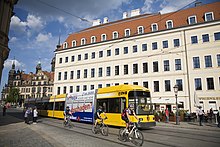
Back Ekostad Afrikaans مدينة مستدامة Arabic Стабиллĕ хула CV Ecociudad Spanish شهر پایدار Persian Kestävä kaupunki Finnish Ville durable French עיר בת-קיימא HE 持続可能な都市 Japanese 생태도시 Korean
This article needs additional citations for verification. (April 2019) |

| Part of a series on |
| Sustainable energy |
|---|
 |
A sustainable city, eco-city, or green city is a city designed with consideration for social, economic, environmental impact (commonly referred to as the triple bottom line), and resilient habitat for existing populations, without compromising the ability of future generations to experience the same.[1] The UN Sustainable Development Goal 11 defines sustainable cities as those that are dedicated to achieving green sustainability, social sustainability and economic sustainability. They are committed to doing so by enabling opportunities for all through a design focused on inclusivity as well as maintaining a sustainable economic growth. The focus will also includes minimizing required inputs of energy, water, and food, and drastically reducing waste, output of heat, air pollution – CO2, methane, and water pollution.[2] Richard Register, a visual artist, first coined the term ecocity in his 1987 book Ecocity Berkeley: Building Cities for a Healthy Future, where he offers innovative city planning solutions that would work anywhere.[3] Other leading figures who envisioned sustainable cities are architect Paul F Downton, who later founded the company Ecopolis Pty Ltd, as well as authors Timothy Beatley and Steffen Lehmann, who have written extensively on the subject. The field of industrial ecology is sometimes used in planning these cities.
The UN Environment Programme calls out that most cities today are struggling with environmental degradation, traffic congestion, inadequate urban infrastructure, in addition to a lack of basic services, such as water supply, sanitation, and waste management. A sustainable city should promote economic growth and meet the basic needs of its inhabitants, while creating sustainable living conditions for all.[4] Ideally, a sustainable city is one that creates an enduring way of life across the four domains of ecology, economics, politics, and culture. The European Investment Bank is assisting cities in the development of long-term strategies in fields including renewable transportation, energy efficiency, sustainable housing, education, and health care. The European Investment Bank has spent more than €150 billion in bettering cities over the last eight years.[5][6]
Cities occupy just 3 percent of the Earth's land but account for 60 to 80 percent of energy consumption and at least 70 percent of carbon emissions. Thus, creating safe, resilient, and sustainable cities is one of the top priorities of the Sustainable Development Goals.[7] The Adelaide City Council states that socially sustainable cities should be equitable, diverse, connected, democratic, and provide a good quality of life.[8] Priorities of a sustainable city include the ability to feed itself with a sustainable reliance on the surrounding natural environment and the ability to power itself with renewable sources of energy, while creating the smallest conceivable ecological footprint and the lowest quantity of pollution achievable. All of this is to be accomplished by efficient land use, composting organic matter, recycling used materials, and/or converting waste-to-energy. The idea is that these contributions will lead to a decrease of the city's impact on climate change.
Today, 55 percent of the world is estimated to be living in urban areas and the United Nations estimates that by the year 2050, that number will rise to 70 percent.[9] By 2050, there may be nearly 2.5 more billion individuals living in urban cities, possibly making it more difficult to create more sustainable communities.[10] These large communities provide both challenges and opportunities for environmentally-conscious developers. There are distinct advantages to further defining and working towards the goals of sustainable cities. Humans thrive in urban spaces that foster social connections. Richard Florida, an urban studies theorist, focuses on the social impact of sustainable cities and states that cities need more than a competitive business climate; they should promote a great people climate that appeals to individuals and families of all types. Because of this, a shift to denser urban living would provide an outlet for social interaction and conditions under which humans can prosper. These types of urban areas would also promote the use of public transit, walkability, and biking which would benefit citizens' health as well as benefiting the environment.[11][12]
- ^ "The Triple Bottom Line: What Is It and How Does It Work?". www.ibrc.indiana.edu. Archived from the original on 2019-09-30. Retrieved 2019-10-02.
- ^ Larsen, Tove A.; Hoffmann, Sabine; Lüthi, Christoph; Truffer, Bernhard; Maurer, Max (2016). "Emerging solutions to the water challenges of an urbanizing world". Science. 352 (6288): 928–933. Bibcode:2016Sci...352..928L. doi:10.1126/science.aad8641. hdl:1874/340345. PMID 27199414. S2CID 9690225.
- ^ Register, Richard (1987). Ecocity Berkeley: Building Cities for a Healthy Future. North Atlantic Books. ISBN 9781556430091.
- ^ "Sustainable Cities". UNEP – UN Environment Programme. 2018-01-23. Archived from the original on 2021-01-19. Retrieved 2020-09-22.
- ^ "Barcelona creates more green space as COVID-19 urban planning meets climate action". European Investment Bank. Archived from the original on 2021-04-20. Retrieved 2021-04-20.
- ^ "Urban Development sector". EIB.org. Archived from the original on 2021-04-17. Retrieved 2021-04-20.
- ^ "Goal 11: Sustainable cities and communities". UNDP. Archived from the original on 2021-05-04. Retrieved 2020-09-22.
- ^ "Adelaide green city | WWF". wwf.panda.org. Archived from the original on 2021-11-22. Retrieved 2019-10-02.
- ^ "7 innovative projects making cities more sustainable". World Economic Forum. 2020-09-22. Archived from the original on 2020-09-22. Retrieved 2020-09-22.
- ^ "Generating power". United Nations Climate Action. United Nations. Retrieved 20 October 2022.
- ^ "The Sustainable SITES Initiative® (SITES®) | asla.org". www.asla.org. Retrieved 2022-06-18.
- ^ Hartig, Terry; Kahn, Peter H. (2016). "Living in cities, naturally". Science. 352 (6288): 938–940. Bibcode:2016Sci...352..938H. doi:10.1126/science.aaf3759. PMID 27199417. S2CID 206647916.
© MMXXIII Rich X Search. We shall prevail. All rights reserved. Rich X Search